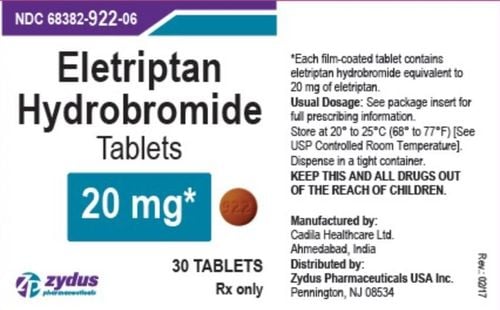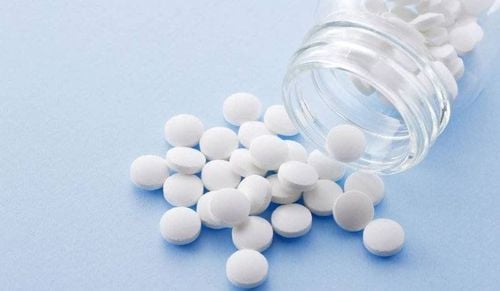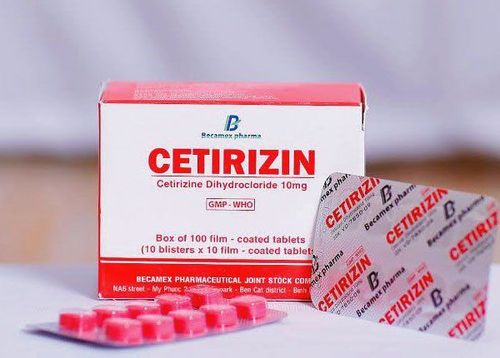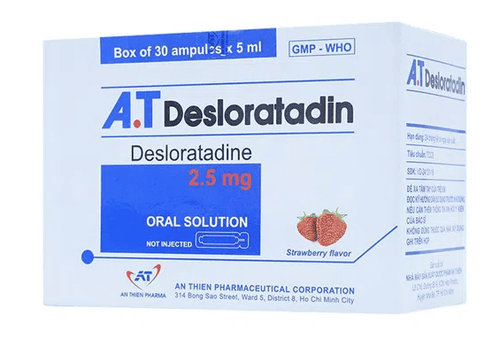This is an automatically translated article.
Ciplactin is an anti-allergic drug indicated for acute or chronic urticaria, allergic rhinitis, eczema, ... So the use of the drug and what should be noted when using the drug?
1. What is Ciplactin?
Ciplactin has the main ingredient Cyproheptadine - a second generation antihistamine of the piperidine group. Ciplactin is an anti-allergic drug that calms the nervous system, induces appetite, and stimulates digestion. This is an antagonist of serotonin and histamine at the receptor sites, thereby reducing itching and sedation.
Ciplactin drug is well absorbed from the gastrointestinal tract with food due to lipid solubility, metabolism in the liver and distribution throughout the body. Finally eliminated by the kidneys.
2. Indications of the drug Ciplactin
Ciplactin is indicated for the treatment of the following cases
Acute or chronic urticaria. Seasonal allergic rhinitis, chronic vasomotor rhinitis. Improves allergic reactions to blood or plasma. Migraine due to vascular disease. Angioedema - neuropathy. Allergic dermatitis. Itching due to skin allergy, touch. The patient is anorexic and physically exhausted.
3. Contraindications of the drug Ciplactin
In some cases, Ciplactin should not be used.
Allergy to Cyproheptadine or any other ingredient of the drug. Angle closure glaucoma. Patient has edema and urinary retention. Newborns, premature babies. Pregnant women are contraindicated to use Ciplactin The drug is not safe for children under 2 years old, especially premature babies, so do not use Ciplactin for this object and women who are breastfeeding. Note when using Ciplactin
Overdose in children causes central nervous system depression, convulsions, hallucinations, respiratory arrest. Ciplactin may be a decrease in alertness, in children may cause irritation. The drug has a sedative effect, reducing concentration. Therefore, patients do jobs that require concentration, meticulousness and caution when using them. Patients with a history of asthma, hyperthyroidism, and cardiovascular diseases should use the drug with caution and monitor it during drug therapy.
4. Drug Interactions of Ciplactin
Co-administration of Ciplactin with analgesics and central nervous system depressants increases the effectiveness of the drug.
MAO inhibitors when used together with Ciplactin prolong the duration and enhance the anticholinergic effect of the drug.
Alcohol, tranquilizers, sleeping pills, anti-anxiety drugs taken with Ciplactin increase the effects of both.
5. Dosage and how to use Ciplactin
How to use:
Ciplactin is prepared in the form of oral syrup. Usually used for children over 2 years old. Take the medicine directly during or after a meal. Dosage in adults:
Usual dose: 10ml/time x 3 times/day. Chronic urticaria: 5ml/time x 3 times/day. Acute vascular migraine: 10ml/time, repeat after 1⁄2 hours. Patient with exhaustion, anorexia: 10ml/time x 3 times/day. Dosage in children
Children 3-6 years old: 5ml/time x 3 times/day. Children from 7-14 years old: 10ml/time x 3 times/day.
6. Side effects of the drug Ciplactin
Some unwanted effects when using Ciplactin
Dizziness, drowsiness, dry mouth. Confusion, restlessness, excitement, nervousness, irritability. Tremor, paresthesia, neuritis. Hallucinations, hysteria, fainting. Convulsions. Anaphylactic reactions, rash, itching, edema. Urticaria, sensitivity to light. Increased sweating. Blurred vision, double vision, tinnitus, acute labyrinthitis. Palpitations, increased heart rate, nervousness. Thus, Ciplactin is an antihistamine commonly indicated in cases of allergies and hypersensitivity. The drug in the form of syrup is easy to use for children, it is necessary to pay attention to the correct dosage to avoid possible unwanted reactions.
Please dial HOTLINE for more information or register for an appointment HERE. Download MyVinmec app to make appointments faster and to manage your bookings easily.













